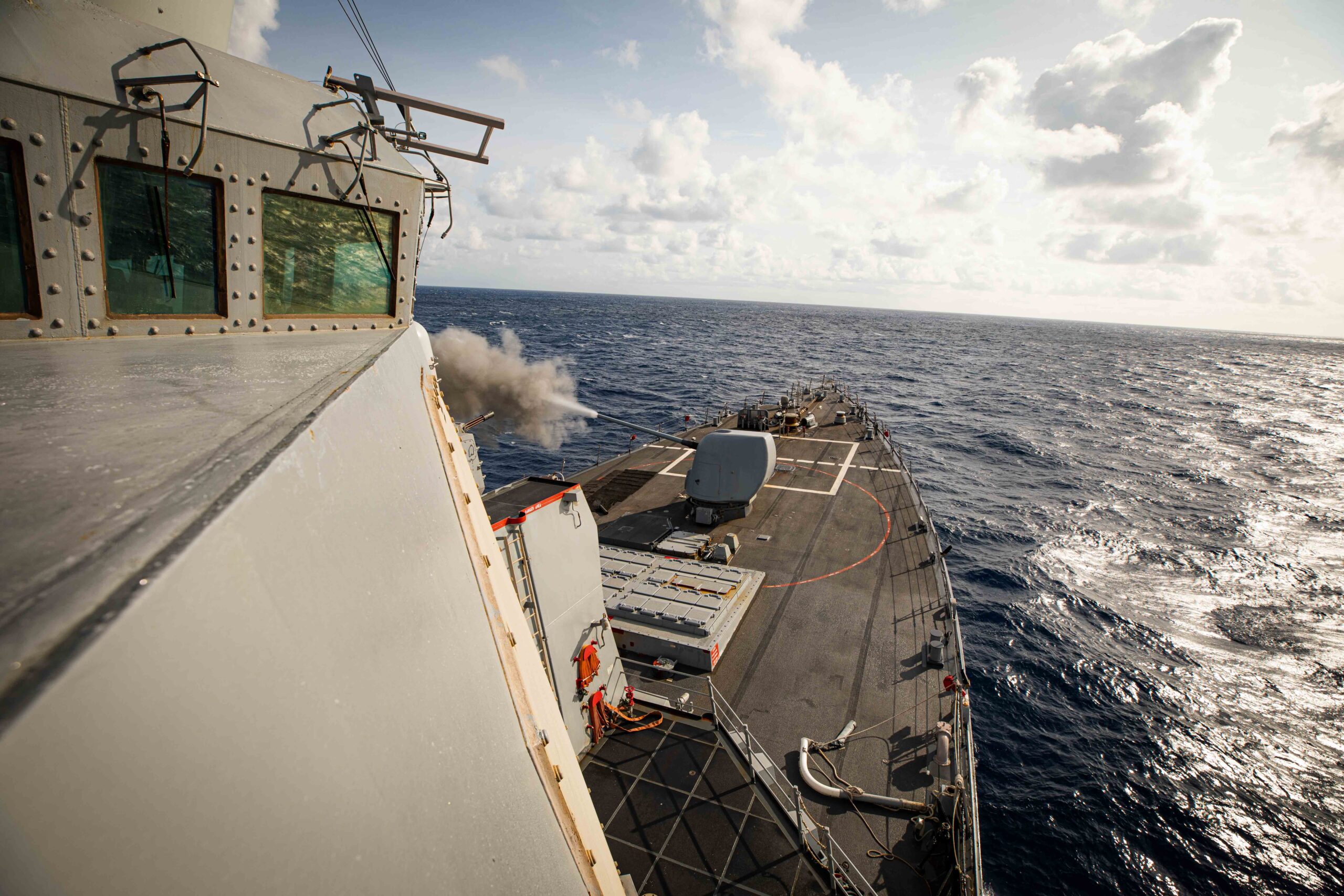

After a nearly eight-month deployment shooting down missiles and drones every week, Navy commander of the USS Carney told reporters that the crew was put to the test with the mere seconds it had to respond to anti-ship ballistic missiles, ASBMs, launched by the Houthis from Yemen.
“The ASBM threat is very challenging. It’s very dynamic and it’s very fast,” said Cmdr. Jeremy Robertson, commanding officer of USS Carney. “Because of that, we have to have 100% confidence in my [Tactical Action Officers] and all of the watch teams and all of the systems that we have that are designed to detect that and make sure that the ship is protecting itself.”
The Houthi attacks in the Red Sea, which began in early October, marked a historic first for active combat engagement of anti-ship ballistic missiles. On Dec. 26, the USS Laboon, with assistance from F/A-18 Super Hornets from the Eisenhower Carrier Strike Group, downed three Houthi ASBMs along with twelve one-way attack drones and two land attack cruise missiles fired by the Houthis over a 10-hour period.
“The Houthis are the first entity in the history of the world to use anti-ship ballistic missiles ever,” Vice Adm. Brad Cooper told 60 Minutes in February. “No one has ever used an anti-ship ballistic missile certainly against commercial shipping, much less against U.S. Navy ships.”
Since then, the Navy has taken the opportunity to learn from the USS Carney’s operations in the Middle East over the last few months, especially regarding speed, Robertson said.
Within literal seconds, the USS Carney team had to detect the missile threat and decide how to engage it.
“Is it inbound? Is it in the envelope that we can engage? And then very quickly make sure that there’s no one top side. You don’t want anyone to get hurt that’s top side,” Robertson said. “Honestly from start to finish, it’s anywhere from nine to 20 seconds.”
Robertson spoke with reporters Monday after the Arleigh Burke-class guided-missile destroyer USS Carney returned to Naval Station Mayport, Florida on Sunday, marking an end to its historic eight-month deployment.
Since October, the USS Carney engaged Houthi-launched weapons targeting commercial ships in the Red Sea 51 times, officials said. The USS Carney also conducted two defensive strikes against Houthi targets in Yemen which destroyed 20 targets and one Iranian-launched medium-range ballistic missile.
Subscribe to Task & Purpose today. Get the latest military news and culture in your inbox daily.
Robertson declined to offer specifics about the weapon systems that the USS Carney used to shoot down threats in the Red Sea. The ship is equipped with the Navy’s latest Surface Warfare Combat System which includes Tomahawk missiles for land attacks, Harpoon anti-surface missiles, and a 5”/54 caliber gun, which in conjunction with the MK 34 Gun Weapon System, is an anti-surface weapon that can be used for close-in air contacts or to support forces on land.
“When we’re in the environment we were in for as long as we were, we realized that we we’re gonna have to do that layered defense to keep in the fight. It’s not an endless pew-pew-pew magazine,” Robertson said. “We were able to figure out that we would be able to do some five-inch engagements, that the targets were predictable enough, I guess I could say, and do that layered defense and put the ship in the best position to be able to employ the five-inch weapon system.”
The Houthis anti-ship missiles, largely sourced from Iran, have grown in capability over the last decade, according to the International Institute for Strategic Studies, IISS, think tank.
“While Western military vessels have advanced air and missile-defence capabilities – using them to down Houthi missiles and UAVs – they are constrained by the number of interceptor missiles they can carry and the challenge of restocking depleted inventories,” Fabian Hinz wrote in an IISS article.
Robertson said the deployment was a good learning experience for his junior sailors and that most of the crew’s anxiety came after the first engagement because a “pattern of life” with the attacks hadn’t yet been established.
“Every day was completely different from one another,” he said. “Some days you got no activity. Some days you had an activity where there’d be a launch and nothing would actually make it into the Red Sea. Some days there were, like October 19th, where we had 19 threats – so no real certainty.”
While the USS Carney returned home Sunday, attacks in the Red Sea continued. On Saturday, a Houthi-launched anti-ship ballistic missile hit a Panamanian-flagged, Greek-owned and operated oil tanker that most recently docked in Russia and was bound for China, according to U.S. Central Command.
Upon its return, Navy Secretary Carlos Del Toro presented the Navy Unit Commendation to the crew “for outstanding performance in action against terrorist forces.”
“Through their bold and courageous actions, the Carney Team promoted regional stability,” Del Toro said in his speech welcoming the crew back to Florida. “They protected vital global commerce, defended key allies and partners, deterred aggression, and forged partnerships founded on trust and unity of effort against violations of international law.”
The latest on Task & Purpose
- F-15E pilot, in a jet called ‘Mullet,’ packs Zyn and kills drones
- 10th Mountain Division rolls more than 500 miles across Finland, Sweden and Norway
- Army eliminates online courses to stop ‘overwhelming’ soldiers
- It’s Military Working Dog official picture day
- Colorado soldier dies in training accident at Fort Johnson, Louisiana